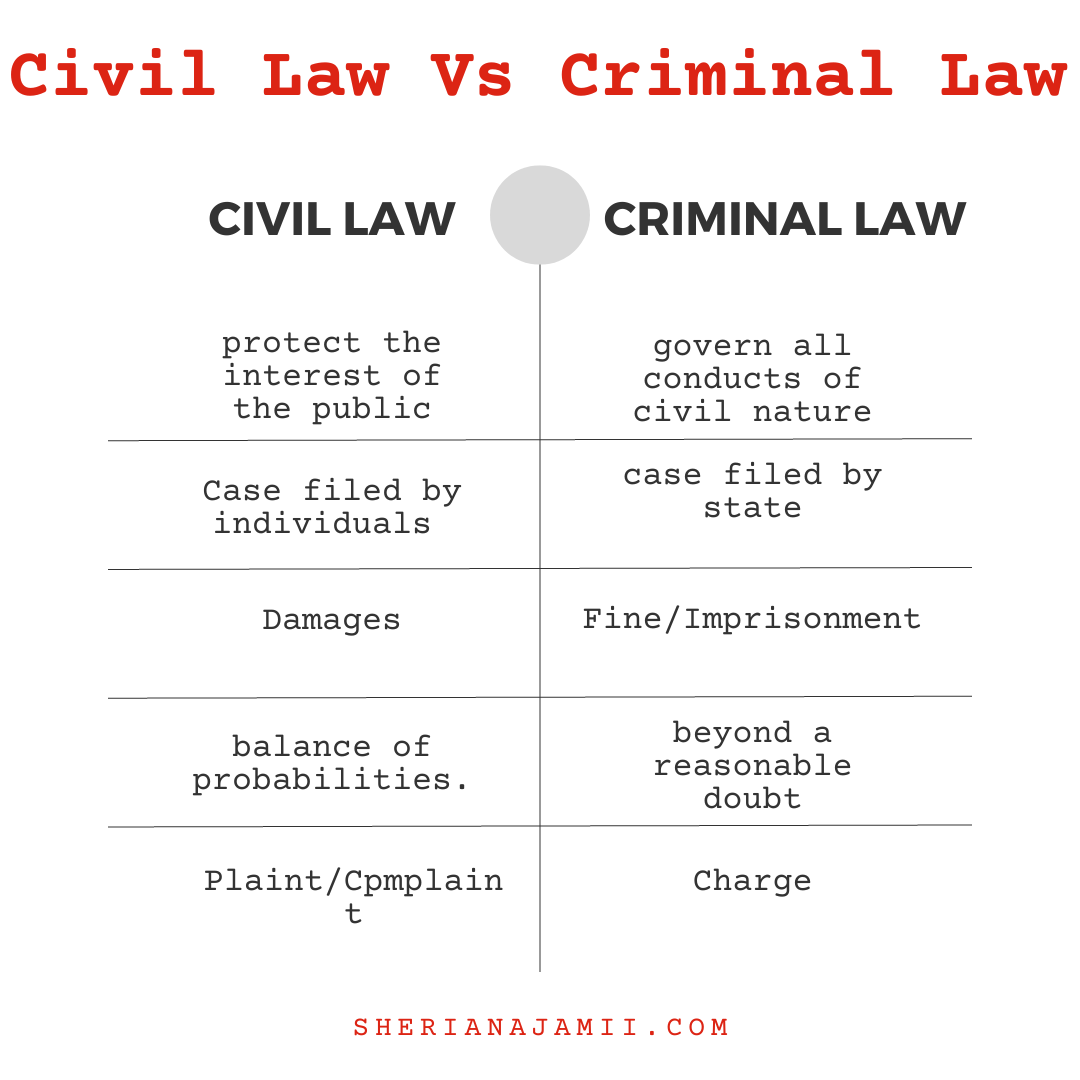
Ready to Master the Art of Persuasive Communication? Unlock Your Success Today!

Among others, the law can be categorized into two major branches i.e. Civil law vs Criminal law
Sometimes you may be confused about how those two branches of the law operate. If you are eager to understand these branches keep reading.
My focus here is to tell you every important thing you need to know about civil law and criminal law.
specifically will cover;
Transform Your Communication, Elevate Your Career!
Ready to take your professional communication skills to new heights? Dive into the world of persuasive business correspondence with my latest book, “From Pen to Profit: The Ultimate Guide to Crafting Persuasive Business Correspondence.”

What You’ll Gain:
Let’s get started
See also: Other classifications of law
Jump to section
Civil law can be defined to mean a body of rules/principles set by competent authority to govern all conducts of civil nature, for example, contracts, labor & employment, torts, family & marriage, etc.
Generally, civil law can be divided into two types that is substantive civil law and procedural civil law
Procedural civil law Is the branch of civil law that is a directory in nature. It deals with legal steps which individuals shall comply with when seeking a particular legal right against an individual or corporation in a court of law or any other organs established by law.
The main objective of procedural law is to provide a guide to attain justice or any legal right.
Example of procedural civil law includes civil procedure/litigation, Evidence law, procedural labor law, etc.
Substantive civil law is the branch of civil law that provides for the rights and duties of individuals. Example of substantive civil law includes the law of tort, the law of contract, employment law, Human right law, etc.
Generally, civil procedural law works as a servant of civil substantive law.
For Example, if a person commits a tort or breach of contract, tort, and contract are substantive laws that provide only the rights and duties of individuals, therefore, in order for that person to claim his right on tort or contract, he must invoke procedural law into play. Procedural law acts as a guide for individual rights.
To understand more in that area you may consider reading this article on how procedural law works.
Criminal law is the branch of law designated to protect the interest of the public. Criminal law defines the duty, which a person owes to society in contrast to civil law, which is primarily concerned with the rights of individuals among themselves.
Any law which has been set up to protect the public interest is an example of criminal law, it may include anti-money laundry law, corruption law, anti-drugs law, ant-robbery law, etc.
Like civil law, criminal law can also be categorized into two types; i.e. Procedural criminal law and Substantive criminal law
Substantive criminal law is a branch of criminal law that creates and defines offenses and offers penalties/punishment to the offenders. Examples of substantive criminal law include Penal Code, Economic crimes, anti-money laundry, etc.
Substantive criminal law is primarily concerned with creating offenses that are punishable by law, defining and classification of crimes (for example crimes against morality, felony, etc), stating the principles of criminal liability (actus reus and mens rea), setting the jurisdiction of criminal courts and stating the punishments of the offenders.
Procedural criminal law is the way in which substantive criminal law is applied.
It is the way in which the prosecution conducts its case, and also the way in which the courts handle criminal matters that are within their jurisdiction.
It is also the modality upon which criminal justice is put into effect.
Procedural criminal law is applied in criminal cases as a means by which the public and the accused person can obtain their rights granted by law.
It shows the duties and rights of both the state and the accused person when dealing with criminal offenses.
It strikes the balance between an individual’s liberties versus public interest.
An individual’s liberty is safeguarded when proper rules of finding the truth are followed so that one cannot be deprived of his freedom without justifiable cause.
Example of procedural criminal law includes criminal procedure, evidence law (specifically deals with proof), extradition law, etc.
You may also read: procedures in the criminal justice system
| KEY POINT | CIVIL LAW | CRIMINAL LAW |
|---|---|---|
| Mode of Operation/Focus | govern all conducts of civil nature. | protects the interest of the public |
| How Case Is Initiated | the plaintiff/claimant/victim or his/her attorney initiates the case and prosecutes. | In criminal law, it is the state, which initiates the case and prosecutes. The claimant/victim can never initiate the criminal case but he/she will be the key witness in the state’s case. |
| Mode of Punishment | In civil law the defendant once found liable has to pay damages/compensation to the plaintiff | in criminal law the offender once found guilty is sentenced to a fine or imprisonment |
| Burden of Proof | In civil law, the burden of proof is on the balance of probabilities | The burden of proof in criminal law is beyond a reasonable doubt. |
| Parties | The parties involved in a criminal case are state versus individual, technically addressed as republic versus accused person(s). | In civil cases, parties are individuals. The party who sued is called the plaintiff/claimant while the one sued is called the defendant/respondent. |
| Document Used To Initiate the Case | The document used to institute a criminal case is called a charge | document used to initiate a normal civil suit is called plaint/complaint |
| Limitation of Time | ll Civil claims have a time limitation on the institution of the case | There is no time limit to instituting a criminal case. time never runs against the state. |
| Flexibility | flexible | strict/rigid. |
| Outcome | civil law are whether the person is liable or not. | The end result of any criminal law procedure is to determine whether the person is guilty or innocent |
Criminal law is the branch of law designated to protect the interest of the public while civil law is the branch of law designed to govern all conduct of civil nature.
In criminal law, it is the state, which initiates the case and prosecutes it. The claimant/victim can never initiate the criminal case but he/she will be the key witness in the state’s case.
When talk about criminal law is where the state is directly interested while in civil law it is the plaintiff/claimant/victim or his/her attorney who initiates the case and prosecutes.
In civil law the defendant once found liable has to pay damages/compensation to the plaintiff while in criminal law the offender once found guilty is sentenced to a fine or imprisonment.
The burden of proof in criminal law is beyond a reasonable doubt.
That means the prosecution has the burden of proving its case beyond a reasonable doubt that the accused person is guilty of the offense charged.
In civil law, the burden of proof is on the balance of probabilities.
That means the plaintiff has the burden of proving the existence of any fact (s) as to his legal right or liability of another party on the balance of probabilities
Read also: what is a burden of proof and how it works
The parties involved in a criminal case state versus individual, technically addressed as republic versus accused person(s).
In civil cases, parties are individuals. The party who sued is called the plaintiff/claimant while the one sued is called the defendant/respondent.
The document used to institute a criminal case is called a charge while the document used to initiate a normal civil suit is called a plaint
Read also: what are pleadings and how they work
All Civil claims have a time limitation on the institution of the case.
For instance, the case on contract may only be initiated within 6 years from when the cause of action was raised while the case on the land is 12 years.
That means if you have a land dispute you have to file your case within 12 years, above that, your claim will be dismissed unless you seek an extension of time.
In criminal cases, things are totally different.
There is no time limit to instituting a criminal case; a case can be filled at any time when circumstance renders it necessary even after a long period of time.
In short, time never runs against the state.
Civil law is flexible while criminal law is strict/rigid.
In civil law, the court is free to modify, delete, and create new principles and rules which govern matters of civil nature. For example, courts are free to create a new form of tort.
The principles of criminal liability are very strict and rigid. The court is supposed to apply them with no adjustment for the interest of justice.
For example, the maxim ‘Nulla poena sine lege‘ means no offense without law.
That means a person cannot be accused to commit an offense that is not stated by any law to that effect
Another example is, in criminal law, a person can never be criminally responsible for the actions of another i.e. a father cannot be accused of the criminal activities of his son.
But in civil law a person may be liable for the act of another, for example, a master can be liable for the acts of his servant or a principal can be liable for the acts of the agent, etc.
The end result of any criminal law procedure is to determine whether the person is guilty or innocent while the end results in civil law are whether the person is liable or not.
Apart from those differences, there are some areas in which civil law and criminal law are related.
The following are the similarity between civil law and criminal law
My task was to avail you of every important element you need to know about Civil Law Vs Criminal Law
The bottom line is;